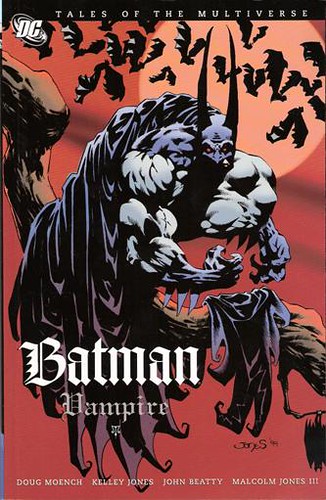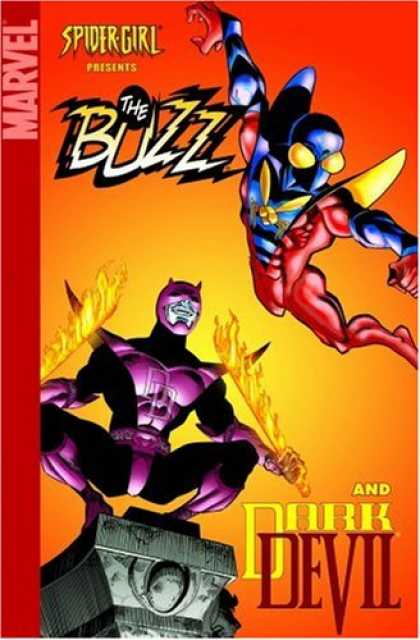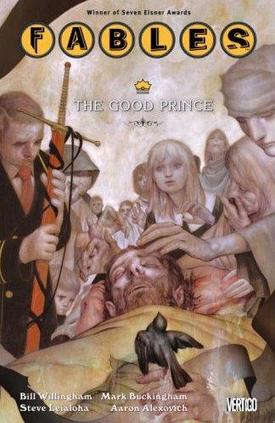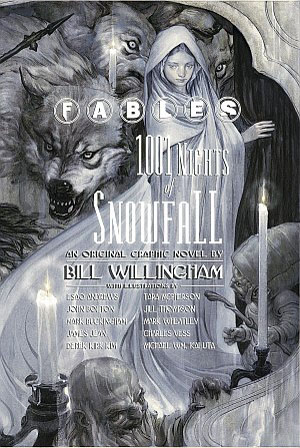Essential Marvel Horror, v. 1
Collects: Ghost Rider #1-2, Marvel Spotlight #12-24, Son of Satan #1-8, Marvel Two-in-One #14, Marvel Team-Up #32 and 80-1, Vampire Tales #2-3, Haunt of Horror #2 and 4-5, Marvel Premiere #27, Marvel Preview #7 (1973-7, 1979)
Released: November 2006 (Marvel)
Format: 608 pages / black and white / $16.99 / ISBN: 078512196x
Essential Marvel Horror, v. 1 gained its name, I was convinced when it was released, because Marvel was too squeamish to publish Essential Son of Satan (or Children of Satan).18
Marvel Horror features two protagonists: Daimon Hellstrom, Son of Satan, and his sister, Satana. Hellstrom, being a square who sides with “humanity” over “the forces of evil,” gets the bulk of the book, but his darker sister gets her share at the end. Unfortunately, the shift in tone and style between these two is likely to spin the reader’s head around like that girl’s in The Exorcist.
 Hellstrom is a rarity: an academic hero. (Ray Palmer is a professor; are there other superheroes who work for a university?) In his Marvel Spotlight series, he battles his father’s forces in St. Louis while being affiliated with Gateway University; in his Son of Satan series, he goes to work for the University of the District of Columbia. I prefer the Spotlight issues, written by Steve Gerber; they were consciously superheroic, with Hellstrom fighting a new supernatural menace each month and trying to keep the squares in St. Louis from learning about it. Why St. Louis? I don’t know, but it’s no goofier than fighting demons in New York City.
Hellstrom is a rarity: an academic hero. (Ray Palmer is a professor; are there other superheroes who work for a university?) In his Marvel Spotlight series, he battles his father’s forces in St. Louis while being affiliated with Gateway University; in his Son of Satan series, he goes to work for the University of the District of Columbia. I prefer the Spotlight issues, written by Steve Gerber; they were consciously superheroic, with Hellstrom fighting a new supernatural menace each month and trying to keep the squares in St. Louis from learning about it. Why St. Louis? I don’t know, but it’s no goofier than fighting demons in New York City.
(Plus, Hellstrom transforms into his demonic alter ego by raising both hands with three fingers pointed upward, making the sign of his demonic trident. Yeah, right — laziest transformation ever.)
The eponymous title, which was mostly written by John Warner, seemed more crowded and more blatantly supernatural, treading ground already trammeled. Thematically, yes, it’s appropriate, but it’s less enjoyable, trying to tread the ground between the superheroes and Marvel horror mags.
And then there are issues of Marvel Team-Up and Marvel Two-in-One, the superheroist of the Marvel superhero comics. Hellstrom got his start in Ghost Rider, which wasn’t a straight superhero comic but was never incredibly far from it.
Gene Colan is perfect for this subject matter; unfortunately, he only does two issues. The other superhero artists … not so much. Not even one of my favorite superhero artists, Sal Buscema, really does the subject justice. On the other hand, they draw demons better than later artists, especially those involved in the Inferno crossover, who believed evil was best represented in Technicolor.
Satana, Daimon’s sister, was featured mainly in Marvel horror magazines. These stand out against the crowd; they are serious, drawn for a mature audience who doesn’t want to see superheroes. The plots are dark, and while they might not match the top of the horror market, they have a unified goal and show us the horror of a child of Satan gone wrong (or right, from Satan’s point of view). Not bound by the Comics Code or its usual kiddie audience, Marvel let the creators have free rein in subject matter and format, occasionally publishing illustrated texts that described Satana’s deeds.
I’m not entirely sure Chris Claremont, who wrote the bulk of the Satana stuff, was the right person for the job, for two reasons. One, his overwrought writing style, which was only beginning here, is more suited to the less serious and self-conscious superhero comics. And two, this is dangerous for him; Claremont loved writing powerful women, and in his later days, became obsessed with certain … well, let’s say tropes, because “fetishes” is a loaded word.
I won’t say the art in these issues are better, but I will say they are striking, while the Comics Code constrained the others so they were quite forgettable. Straying outside their usual bullpen for Satana’s stories, Marvel published contributions from international artists. Their work is moody, dark, vivid even in black and white. These issues really make the volume, and it’s a shame the rest of the book contrasts so sharply with it.
Since it’s Halloween, I’m legally required to answer this question: Is it scary? Well, the Hellstrom parts are decidedly not so. Marvel has neutered most of its dread evil Lords of the Afterlife and all of its demons so superheroes can fight them. The Satana parts? Let’s just say they feel nothing like a superhero story, with a definite sense that evil might win. That’s not enough to rescue the volume as a whole, however.
Rating: ![]()
![]() (2 of 5)
(2 of 5)
Labels: 2, Chris Claremont, daimon hellstrom, Essentials, Gene Colan, john warner, Marvel, Sal Buscema, satana, St. Louis, Steve Gerber, Washington DC





 I was disappointed in “Red Rain.” I found Batman to be little more than the generic hero for the story. Other than the “bat” link between hero and villain, there’s not much to the conflict that couldn’t have been filled by some other street-level hero. Perhaps I am unappreciative of some natural link between vampires and Batman; perhaps I’m not properly reveling in the additive property awesomeness that results in super awesomeness when you add Batman to vampires. But the plot feels like a cheat, with Tanya, a vampire who fights against Dracula, imparting vampiric strength and attributes to Batman and starting him down the road to his eventual transformation. There’s also a mysterious red rain that literally falls from the sky here and throughout the book; I think it’s supposed to add to the spooky atmosphere, but mainly it looks like a coloring error.
I was disappointed in “Red Rain.” I found Batman to be little more than the generic hero for the story. Other than the “bat” link between hero and villain, there’s not much to the conflict that couldn’t have been filled by some other street-level hero. Perhaps I am unappreciative of some natural link between vampires and Batman; perhaps I’m not properly reveling in the additive property awesomeness that results in super awesomeness when you add Batman to vampires. But the plot feels like a cheat, with Tanya, a vampire who fights against Dracula, imparting vampiric strength and attributes to Batman and starting him down the road to his eventual transformation. There’s also a mysterious red rain that literally falls from the sky here and throughout the book; I think it’s supposed to add to the spooky atmosphere, but mainly it looks like a coloring error. So that leaves the question of whether Buzz and Darkdevil is forgettable or fun, and it’s a split decision. This digest is meant to appeal to hardcore M2-Universe fans, what few there are: the kind of people who have been curious as to what Darkdevil’s deal is. (Until I read this, I never really considered the Buzz to have much of a mysterious backstory.) The usual caveat is M2 stories appeal to those who enjoy old-school comic-book stories, but that’s not really the case here. The Buzz is that sort of story, a fun little bit of fluff full of team ups, mistaken identities, and a classic villain using his only pseudonym. It’s not going to get written up as one of the great stories of the decade, but it is an enjoyable example of the genre; it would fit into the ‘70s / ‘80s Marvel output with no problems.
So that leaves the question of whether Buzz and Darkdevil is forgettable or fun, and it’s a split decision. This digest is meant to appeal to hardcore M2-Universe fans, what few there are: the kind of people who have been curious as to what Darkdevil’s deal is. (Until I read this, I never really considered the Buzz to have much of a mysterious backstory.) The usual caveat is M2 stories appeal to those who enjoy old-school comic-book stories, but that’s not really the case here. The Buzz is that sort of story, a fun little bit of fluff full of team ups, mistaken identities, and a classic villain using his only pseudonym. It’s not going to get written up as one of the great stories of the decade, but it is an enjoyable example of the genre; it would fit into the ‘70s / ‘80s Marvel output with no problems.  (2.5 of 5)
(2.5 of 5)  Mini Marvels still shows its origins as a superhero version of the classic newspaper comic strip, although unlike today’s newspaper strips, it’s funny. The influence of Charles Schulz’s “Peanuts,” seen from early “Bullpen Bits” to Mini Marvels (Giarrusso’s Xavier looks like a cross between Jean-Luc Picard and Charlie Brown), is obvious. But despite the comic-strip roots, Giarrusso makes the transition to longer stories effortlessly.
Mini Marvels still shows its origins as a superhero version of the classic newspaper comic strip, although unlike today’s newspaper strips, it’s funny. The influence of Charles Schulz’s “Peanuts,” seen from early “Bullpen Bits” to Mini Marvels (Giarrusso’s Xavier looks like a cross between Jean-Luc Picard and Charlie Brown), is obvious. But despite the comic-strip roots, Giarrusso makes the transition to longer stories effortlessly.  Writer Bill Willingham’s plot is essentially divided in two: the ramping up of tensions and revelations to what looks like an inevitable war and the story of bumbling janitor Fly, who becomes King Ambrose. The war preparations are more interesting; here, long-term hints are confirmed or denied, further threads are spun, and pieces are put in place for the final conflict. This is the path the series has been journeying down for six or so years, and it dominates the first half of the book.
Writer Bill Willingham’s plot is essentially divided in two: the ramping up of tensions and revelations to what looks like an inevitable war and the story of bumbling janitor Fly, who becomes King Ambrose. The war preparations are more interesting; here, long-term hints are confirmed or denied, further threads are spun, and pieces are put in place for the final conflict. This is the path the series has been journeying down for six or so years, and it dominates the first half of the book.  There are quite a few excellent stories that fill in missing pieces in some of the most prominent characters’ histories. The story of Snow White and the Seven Dwarves is recast as a revenge tale. Old King Cole, a merry old soul in prosperity, is shown as a good king in adversity. Frau Totenkinder, the grandmotherly villain of Hansel and Gretel, truly and frighteningly lives up to her name. Ambrose, the lowly janitor of the Fables’ apartment building, becomes a tragic figure after spending so long as bumbling comic relief; this story should be read before Fables, v. 10: The Good Prince, or it loses most of its emotional impact.
There are quite a few excellent stories that fill in missing pieces in some of the most prominent characters’ histories. The story of Snow White and the Seven Dwarves is recast as a revenge tale. Old King Cole, a merry old soul in prosperity, is shown as a good king in adversity. Frau Totenkinder, the grandmotherly villain of Hansel and Gretel, truly and frighteningly lives up to her name. Ambrose, the lowly janitor of the Fables’ apartment building, becomes a tragic figure after spending so long as bumbling comic relief; this story should be read before Fables, v. 10: The Good Prince, or it loses most of its emotional impact.  And when I say “emotional impact,” I mean more than just the punch to the gut the death of a character gives. The characters complete their emotional arcs — Scott and Emma in their relationship, Wolverine teaming up, as he often does, with a young female X-Man (Armor), Hank and Brand — and although that last pairing smacks of Whedon trying to give some importance to a character he created, it does give the character some closure that will never be followed up on again. The incompleteness of Kitty and Peter’s reunion also hits hard, and it’s predictably the most moving part of Unstoppable.
And when I say “emotional impact,” I mean more than just the punch to the gut the death of a character gives. The characters complete their emotional arcs — Scott and Emma in their relationship, Wolverine teaming up, as he often does, with a young female X-Man (Armor), Hank and Brand — and although that last pairing smacks of Whedon trying to give some importance to a character he created, it does give the character some closure that will never be followed up on again. The incompleteness of Kitty and Peter’s reunion also hits hard, and it’s predictably the most moving part of Unstoppable. (3.5 of 5)
(3.5 of 5) But any character that has been good once is begging to be reused, and into this breach steps writer Ty Templeton and penciller Juan Bobillo. In
But any character that has been good once is begging to be reused, and into this breach steps writer Ty Templeton and penciller Juan Bobillo. In  But Twelve isn’t actually a good deal, and you know why? Because almost two-thirds of the book is useless and irrelevant. If this collection had added the Uncanny X-Men and X-Men issues that preceded the ones included here and dropped Cable and Wolverine, this collection might have been worthwhile. I mean, it’s a simple story: genocidal, idiot-Darwinist Apocalypse and his religious-themed henchmen capture the long-prophesied mutants called the Twelve and try to drain their powers to make Apocalypse all powerful. But no, you’ve got to slog through ancillary stuff to get to the meat.
But Twelve isn’t actually a good deal, and you know why? Because almost two-thirds of the book is useless and irrelevant. If this collection had added the Uncanny X-Men and X-Men issues that preceded the ones included here and dropped Cable and Wolverine, this collection might have been worthwhile. I mean, it’s a simple story: genocidal, idiot-Darwinist Apocalypse and his religious-themed henchmen capture the long-prophesied mutants called the Twelve and try to drain their powers to make Apocalypse all powerful. But no, you’ve got to slog through ancillary stuff to get to the meat.